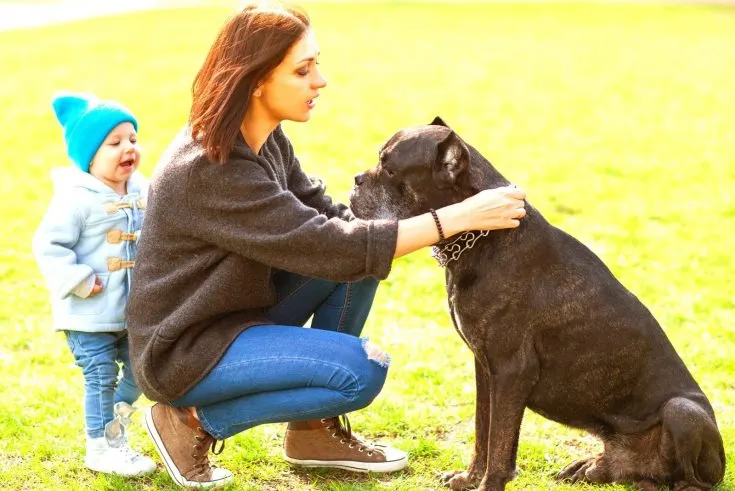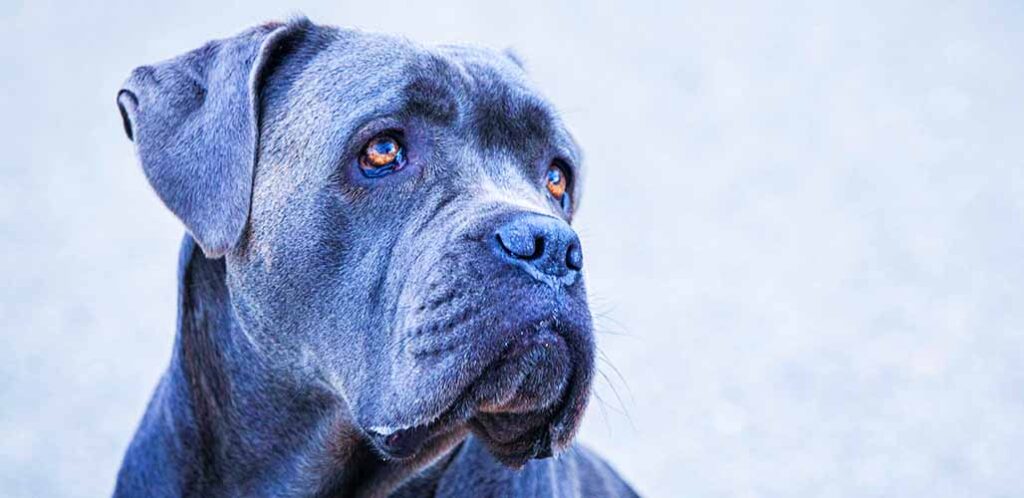Table of Contents
Toggle
An Overview of Cane Corso Health
The well-being of their Cane Corso is a major concern for their owners. Large and powerfully built, the Cane Corso was developed from working dogs. Although this Italian mastiff is typically in excellent health, there are a few things you should know to ensure their continued wellness.
We’ll look at the difficulties of owning a Cane Corso, both as described by other people and as we’ve seen them ourselves.
First, let’s go through the three most crucial factors:
- First, make sure to feed them a diet that is balanced and includes enough protein.
- Second, be sure to give them plenty of exercises.
- Finally, keep an eye on their weight. Problems can occur if they become overweight or obese.
Can you tell me about the typical health problems encountered by cane corsos?

Concerns with the eyes, hip dysplasia, and bloat are just a few of the many health issues that might affect a Cane Corso.
Cane Corso owners may also be worried about their pet’s size. Get your dog on a healthy diet and regular checkups with the advice of your doctor if he or she is overweight.
Cane Corsos may have a variety of health problems including:
- Hip dysplasia
- Eye problems
- Bloat
- Breathing problems
- Heart conditions
- Leg problems
Hip dysplasia in Cane Corsos

Pain, lameness, and arthritis are all symptoms of Cane Corso Hip Dysplasia, a hereditary condition of the hip joint.
Specifically, the hip socket is not properly aligned with the femur, which leads to the condition known as hip dysplasia, which affects a disproportionately high percentage of dogs in this breed. Your dog may have discomfort, and it may even contribute to arthritis in the road.
Cane Corso pups affected by this condition may have trouble getting up and down, and they may walk with a limp. Surgery to realign the hip socket is the standard treatment, and it is usually effective in fixing the issue.
Research by the American Animal Hospital Association (AAHA) has shown that hip dysplasia is the most common health problem in canines. Poor diet, heredity, and obesity are just a few of the suspected triggers.
The American College of Veterinary Surgeons (ACVS) recommends the following: “Canine hip dysplasia (CHD) is a developmental disorder that causes the hip joint to become either unstable or loosely fitted (laxity). Possible hip discomfort, limb dysfunction, and degenerative joint changes are all attributable to laxity in the hip joint.”
Extreme growth and weight gain due to an unhealthy diet might increase the risk of developing coronary heart disease. Most cases of hip dysplasia are seen in giant breed dogs.
We discovered hip dysplasia in one of our Cane Corsos. In the end, we didn’t know for sure until we X-rayed her when she was about two years old. Until the dog matures, we won’t know for sure.
We’ve been quite fortunate that she hasn’t had to go through any discomfort. We’ve made sure she doesn’t overdo it on the activity front and have kept her from doing dangerous things like leaping out of moving cars, but other than that, she’s had a completely normal life and shown no signs of discomfort.
Can Hip Dysplasia in Cane Corsos be Prevented?
Cane Corso hip dysplasia can only be treated surgically, however, there are ways to lessen your dog’s vulnerability to the problem.
Maintaining your dog’s health and fitness throughout their life may help lessen the likelihood that they will develop canine hip dysplasia. Having a healthy, well-rounded diet is crucial.
You should make sure your Cane Corso stays at a healthy weight that corresponds with his age. Hip dysplasia risk is elevated in those who are overweight.
Issues with the Cane Corso’s Eyes
Cane Corsos may have entropion, in which the lower eyelid is abnormally displaced downward, and ectropion, in which the upper eyelid curls inward.
Symptoms of Entropion in Cane Corsos
A common eye condition, entropion occurs when the eyelid turns inward, forcing the eyelashes to brush against the surface of the eye. Irritation and maybe blindness are the results of this. Those responsible for a Cane Corso should keep a close look out for the onset of entropion and immediately take their pet to the clinic if they see any symptoms.
Ectropion In Cane Corsos
Cane Corsos often suffer from eyelid condition known as ectropion. The lower eyelid drops below the orbital socket.
There may be a hereditary component to certain diseases. For most patients, the best option for treatment is surgical intervention. The recovery time after this procedure is short, and the results are reliable.
Cane Corsos Often Have a Cherry Eye
Cherry eyes are caused by a prolapse, specifically a rip in the membrane that lines the third eyelid. Any dog is susceptible to this, but Cane Corso is more vulnerable. Because the cherry eye may be inherited, it’s crucial to ask the breeder about the health of the Cane Corso puppy’s parents.
Is There a Family History of Eye Disease in the Cane Corso?
There is a considerable hereditary propensity for eye problems in the Cane Corso.
Four Italian dog breeds were examined for hereditary eye diseases by the Veterinary Information Network.
Over eighty-one Cane Corsos participated in the study.
In light of these findings, we may say that
“Seventy.4 percent of Cane Corsos had hereditary abnormalities….
Ectropion was thought to be the most heritable defect.”
According to the rest of the white paper:
“Routine eye screening and selective breeding procedures are needed for these breeds due to the high occurrence of ocular diseases.”
Dogs of the Cane Corso breed are prone to bloat.
Bloat, also known as stomach dilatation volvulus, is a life-threatening illness that affects deep-chested huge and gigantic breed dogs like the Cane Corso. Inhaling food too quickly might cause your dog to swallow air, leading to a buildup of gas in his digestive tract.
Gas builds up rapidly in the stomach under these conditions. It may fold in on itself if not addressed straight away (volvulus). There is an urgent need for veterinarian attention to save your pet’s life.
In addition to food, stress may also trigger abdominal swelling.
Additional reasons include:
- Overeating of rich foods like meats
- Drinking too much water before or after meals
- Exercising immediately after eating
- Eating too fast
- Lack of exercise
- Excitement over food
Dogs shouldn’t be fed excessively huge portions. The risk of abdominal distention may be reduced by eating smaller meals more often throughout the day. Our Cane Corsos are fed twice a day, first in the morning and again in the early evening.
These are reinforced with a light snack in the afternoon and another, often an apple, in the late evening.
We have a Cane Corso with breathing issues
Most people mistakenly believe that only short-snout dogs have respiratory difficulties. However, although some dogs may be more at risk for developing respiratory difficulties, any dog might have difficulty breathing.
Clearly, the Cane Corso does not have a snub nose. The nose of a Cane Corso may grow to be fairly lengthy. However, Cane Corsos can have trouble breathing. Dyspnoea is the medical term for this problem.
Dyspnoea is characterized by difficulty breathing. If your Cane Corso is experiencing trouble breathing, it will be noticed rather quickly. It’s audible. It sounds like a person who has just finished doing strenuous physical activity and is gasping for air.
If your Cane Corso has been showing dyspnea symptoms for more than a day, it’s time to make an appointment with the vet.
In certain cases, a Cane Corso’s snoring may be traced back to a bout of moderate dyspnoea. Cane Corsos have a reputation for having a snoring problem. Snoring is frequent in Cane Corsos, so there’s no need to worry if you hear it coming from your dog.
Our senior Cane Corso will soon be 14 this year. Which is rather sprightly for a Cane Corso. Throughout the day, she sometimes has trouble breathing. And especially after she’s taken a little stroll to attend to her natural needs.
But she keeps going; she’s healthy, has enough to eat and drink, and seems content; her tail wags and her attitude is upbeat. So, we just keep an eye on her to make sure she isn’t going through any kind of pain or that her health isn’t declining to the point where she’s in distress.
Does An Active Cane Corso Mean A Happy And Healthy Dog?
Cane Corsos should not be exercised by running or playing fetch; their primary function is hunting.
Cane Corsos benefit greatly from vigorous physical activity like long walks or jogs, games of fetch or catch, and even short swimming once in a while.
Walking about the house or yard, playing with toys, and going for a brief walk or jog around the block are examples of a Cane Corso’s usual day as a family dog.
Naturally, every canine is unique. There is a great deal of variety among canine individuals. We all know that regular exercise is good for a dog’s health, but I must admit that our Cane Corsos have a terrible propensity to be couch potatoes.
And yes, we do remove them. However, on days when things are really frantic, they may only have time for a couple of brief walks per day. The truth is, they couldn’t care less. They immediately go back inside, where they relax and seem contentedly content by lying down.
And our Cane Corsos have had long, healthy lives, so we know that a laid-back approach can be successful as well.
Panosteitis And Cane Corsos
Panosteitis is not a disease unique to the Cane Corso, but it may affect any big dog breed. Usually, this is due to the very fast development seen in giant breeds.
The discomfort caused by panosteitis, an infection of the long bones of the leg, is well-known.
Our male Cane Corso puppy was diagnosed with Panosteitis. Seeing him in such obvious pain was upsetting, yet he never once whined or moaned.
It’s possible that this illness might linger for up to three years. Panosteitis in canines usually clears up after they’ve completed their growth spurt.
It is generally agreed that the ailment will clear up by the age of two. It took nearly exactly three years for our Cane Corso to recover from his limp.
What is the average lifespan of a Cane Corso?
In general, a healthy Cane Corso should live for around 12 years.
Coat color and the health and longevity of cane corsos

Coat color in Cane Corsos has a correlation with health and lifespan. According to studies, Cane Corsos with brindle coats tends to live the longest.
The average longevity of individuals with black brindle coats is 10.3 years, nearly a whole year greater than the average lifespan of those with other coat colors, according to research published in the Open Veterinary Journal. The gain in life expectancy is astronomical, at 10.4 percentage points.
Cane Corsos with uncommon coat colors are likely to be less healthy overall. Health problems might arise from selective breeding between individuals of the same coat color. In dogs, it is not recommended to breed for a certain coat color instead of focusing the animal’s overall health.